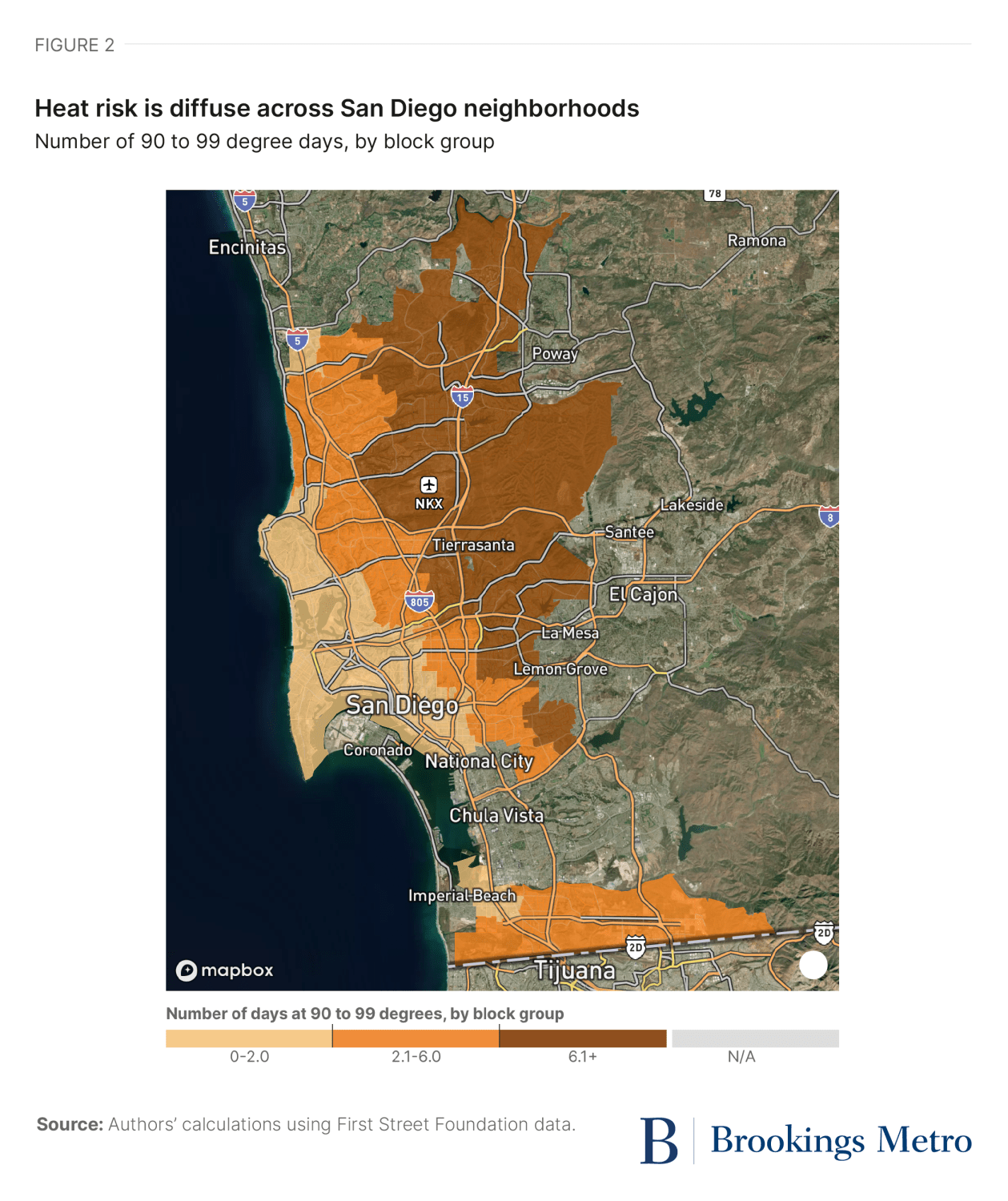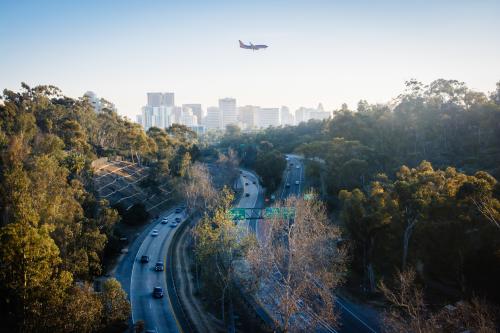Summer is just around the corner for much of the U.S. Traditionally, the season between Memorial Day and Labor Day has strong positive associations: vacations from school and work, basking in sunshine at the beach, enjoying hot dogs and beer at baseball games. But climate change is quickly altering how we collectively dream of summer.
More communities now experience summer temperatures outside the range of what most people find enjoyable. Just as troubling, the average number of extreme heat days—often measured as days with temperatures above 90 degrees—continues to rise each decade. Stretches of intense heat are not only unpleasant, but actively dangerous to human health—and create real, although sometimes subtle, economic costs. Moreover, not all households and communities have the financial resources to protect themselves from heat: Low-income households are less likely to have home air conditioning and often struggle with utility bills.
Heat is in some ways an underrated form of climate risk. Far more media and public attention focuses on acute events like hurricanes, wildfires, and intense storms, which cause highly visible and expensive damage to homes, businesses, and infrastructure. Quieter, chronic stresses like heat and drought draw fewer headlines, but have the potential to impact more people and cause damage through other channels.
In this report, we highlight some of the reasons why Americans should worry more about extreme heat. To demonstrate how such changes look and feel on the ground, we draw on insights from our recent report mapping heat, wildfire, and flood risks across the city of San Diego. In communities across the country, it’s imperative that households, businesses, civic organizations, and local governments start to manage the chronic risks associated with extreme heat, both through physical investments in the built environment and by providing financial resources where needed.
More Americans face exposure to extreme heat than to floods and wildfires
It’s no secret that climate risks vary across geography. Most people could correctly identify Florida and the Gulf Coast as hurricane hotspots, while wildfires are more common in the Mountain West. Over the past few years, localized climate risk data across a variety of dimensions has become more widely available, allowing researchers, governments, and the general public to better understand relative risks across smaller geographic areas. To illustrate climate risks for a non-technical audience, First Street Foundation has developed composite risk scores ranging from 1 (low) to 10 (high) for all properties in the U.S.
Looking at the distribution of risk scores for floods, wildfires, and heat shows a very clear pattern: The typical American property faces a substantially higher risk from heat than from floods or fires. (Wind is omitted from the graphs because our analysis focused on the city of San Diego, where wind risk is extremely low.) As the graphs show, heat risk scores range widely across the country, with more properties clustered toward the middle (4 to 6) and fewer properties at the extremes. By contrast, most properties cluster at the low end of the risk scale for fires and floods, with a small number of properties in the middle and upper ranges. Even in cities like San Diego, which faces above-average wildfire risk, most properties face low fire risk and moderate heat risk.
To help understand why heat risk is more common than the other two categories, the map below shows spatial patterns of heat for the city of San Diego. Heat risk varies across neighborhoods, with areas close to the coast experiencing fewer high heat days than inland areas. But all San Diego neighborhoods face some degree of heat risk.1 By contrast, flood and wildfire risks are more spatially concentrated: A small subset of neighborhoods face high risk, while most neighborhoods have quite low risk.
While the exact spatial patterns of climate risk will vary across cities, the degree of concentration or diffusion has important implications for adaptive strategies. In San Diego, local and regional governments should focus their flood and wildfire risk mitigation efforts—such as upgrading stormwater management systems or clearing brush—in the neighborhoods with the most concentrated risk. Heat mitigation efforts—such as growing new tree canopies or providing shade features at transit stations—may be required across larger portions of the city. Where possible, policymakers should look for investments that can address multiple climate risks at the same time; for instance, increasing the amount of vegetation along sidewalks can reduce temperatures and help with stormwater absorption.
Unlike floods and wildfires, heat poses greater threats to people than to buildings
Intense storms and wildfires draw greater media and public attention both because of their physical visibility and because of the direct economic damages they inflict on buildings and infrastructure. Some observers have called instability in property insurance markets the canary in the coal mine—most Americans are just beginning to feel the pain in their pocketbook from climate change. In coming years, homes and commercial real estate located in areas at higher risk of floods, wind, and fires will likely see falling property values, as well as rising costs and declining availability of property insurance.
Heat is different: it hurts people more than buildings. Extreme heat is dangerous and sometimes fatal for humans, especially for older adults, young children, and people with certain health conditions. (The descriptions of what heat does to the human body are extremely gruesome.) Research has found that hot days can be particularly deadly in parts of the U.S. that are less accustomed to heat, because people have not developed adaptive strategies. For instance, heat waves in the Pacific Northwest lead to more excess deaths in part because homes are less likely to have air conditioning.
While real estate markets may be less worried about heat, higher temperatures will disrupt labor markets. Workers are more prone to on-the-job-accidents and errors on hot days—bad news for worker productivity and company profits. And heat can potentially affect a wide array of the labor force: from outdoor occupations like landscapers and construction workers, to delivery drivers, and even food processing plants in older industrial buildings that lack air conditioning. Many older school buildings also lack well-functioning air conditioning—a serious impediment to children’s learning. Climate change is bringing hot days earlier in the spring semester and lingering later in the fall, implying a higher share of hot school days in the future.
Reducing the damages from extreme heat will require thoughtful, community-wide interventions
Extreme heat, like other manifestations of climate change, will not affect everyone equally. Affluent households who work in white-collar occupations can protect themselves by moving between their air conditioned homes, cars, and offices, all while spending their leisure hours in well-chilled movie theaters, restaurants, and cafes. But this lifestyle isn’t available—or affordable—to everyone.
How can local, state, and federal policymakers and civic organizations provide support to entire communities at higher risk, especially households and businesses with lower incomes? Trying to retrofit millions of older homes, schools, libraries, and businesses with air conditioning will be enormously expensive. Who is expected to foot the bill? Individual homeowners, landlords (passing it along to their tenants), business customers (through higher prices)? Even if American taxpayers subsidize these retrofits through the purchase of heat pumps—as the Inflation Reduction Act enables—many low-income households and business owners will be hard pressed to afford the higher electricity bills. Moreover, ramping up energy usage during citywide or regionwide heat waves will put substantially higher demands on power grids—already a concern during the summer in California.
Even community-level interventions require careful advance planning to be effective. For example, the city of San Diego opened cooling centers to serve lower-income households that lack home air conditioning, but our interviews found that many older adults did not use them because they refused to leave their pets alone. And building-level interventions alone won’t mitigate heat risks for outdoor spaces such as transit stops and athletic fields. In many cities, low-income neighborhoods have fewer trees, public pools, and other natural features that can provide cooling.
Protecting people’s health and safety from extreme heat will require thoughtfully designed and implemented strategies—including greater financial support and technical assistance from state and federal governments. While elected officials and voters may balk at the upfront costs of adaptation, they should also consider the increasingly steep costs of the status quo.
-
Acknowledgements and disclosures
The San Diego Foundation provided support for the climate risk mapping report from which the analysis is drawn. Many thanks to Julia Gill and Caroline George for their excellent help with the data analysis. Any errors and omissions are the responsibilities of the authors.
-
Footnotes
- While wildfire risk is relatively low in the city of San Diego, the county of San Diego—which is home to the largest wildland–urban interface (WUI) by land area in the state—faces much higher wildfire risk. See a discussion box within the full report for more details.
The Brookings Institution is committed to quality, independence, and impact.
We are supported by a diverse array of funders. In line with our values and policies, each Brookings publication represents the sole views of its author(s).







